Must-See LED Stats for 2025 and Beyond May 4, 2025 – Posted in: Lighting Information
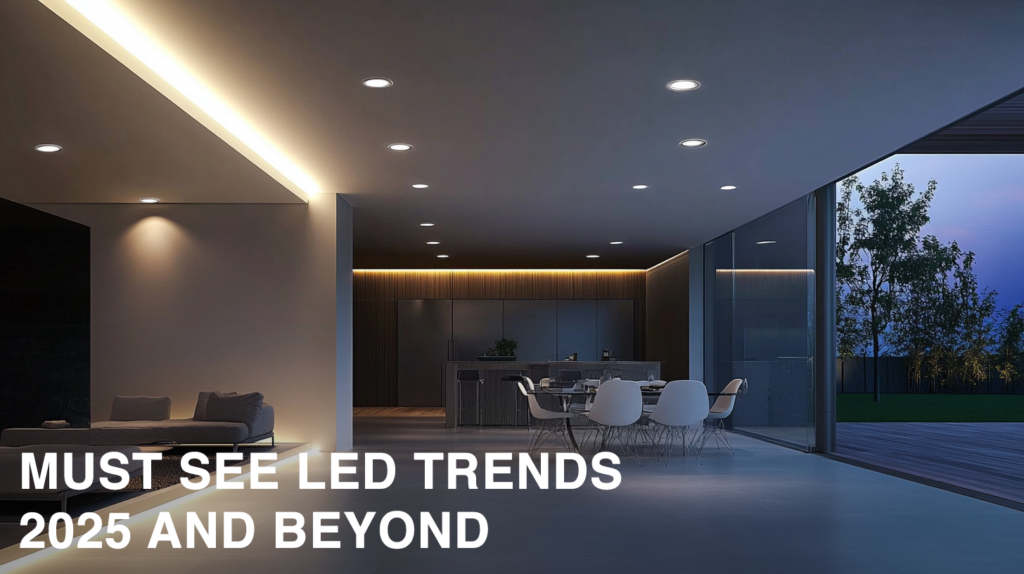
Introduction to LED Lighting Trends
Light Emitting Diode (LED) technology has revolutionized the lighting industry over the past decade, representing one of the most significant advancements in energy-efficient lighting since the invention of the light bulb. LED lighting has rapidly transformed from a niche, expensive technology to the mainstream standard across residential, commercial, and industrial applications.
The compelling combination of energy efficiency, longevity, decreasing costs, and environmental benefits has accelerated global LED adoption. As governments worldwide implement energy efficiency regulations and consumers become increasingly environmentally conscious, the LED lighting market continues to experience remarkable growth.
This comprehensive visual guide presents the latest statistics on LED lighting market growth, adoption rates across different sectors, energy efficiency comparisons, environmental impact, and emerging trends. Through these twelve detailed visualizations, we aim to provide a complete picture of how LED technology is reshaping the lighting landscape globally.
Market Growth
Global LED Lighting Market Growth

This graph illustrates the rapid expansion of the global LED lighting market, which is projected to grow from $81.5 billion in 2023 to an impressive $239.6 billion by 2034. With a compound annual growth rate (CAGR) of 10.53%, this substantial market expansion reflects the increasing global shift toward energy-efficient lighting solutions across all sectors. The steady upward trajectory demonstrates strong market confidence and sustained demand for LED technology.
Source: Roots Analysis LED Lighting Market Report, 2023
LED Market Growth by Region
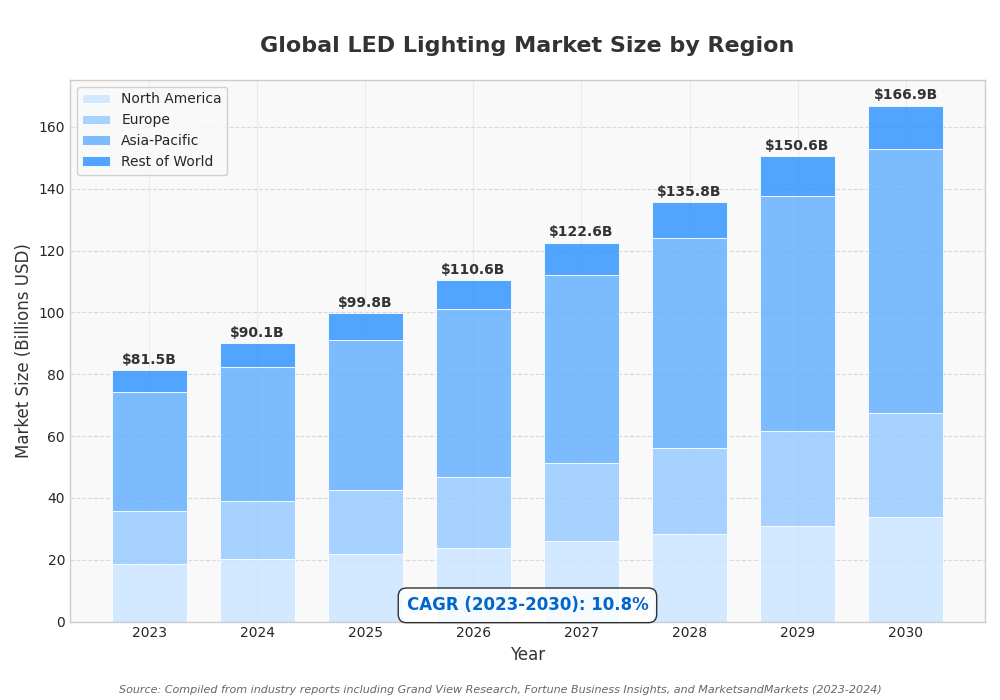
This visualization breaks down the global LED lighting market by geographic regions from 2023 to projected 2030. Asia-Pacific dominates the market and shows the strongest growth trajectory, accounting for approximately 45% of the global market. North America and Europe follow with significant market shares, while emerging economies in the Rest of World category display accelerating adoption rates. The regional disparities reflect differences in infrastructure development, government policies, and economic conditions.
Source: Grand View Research, Fortune Business Insights, 2024
LED Market Share by Application Type
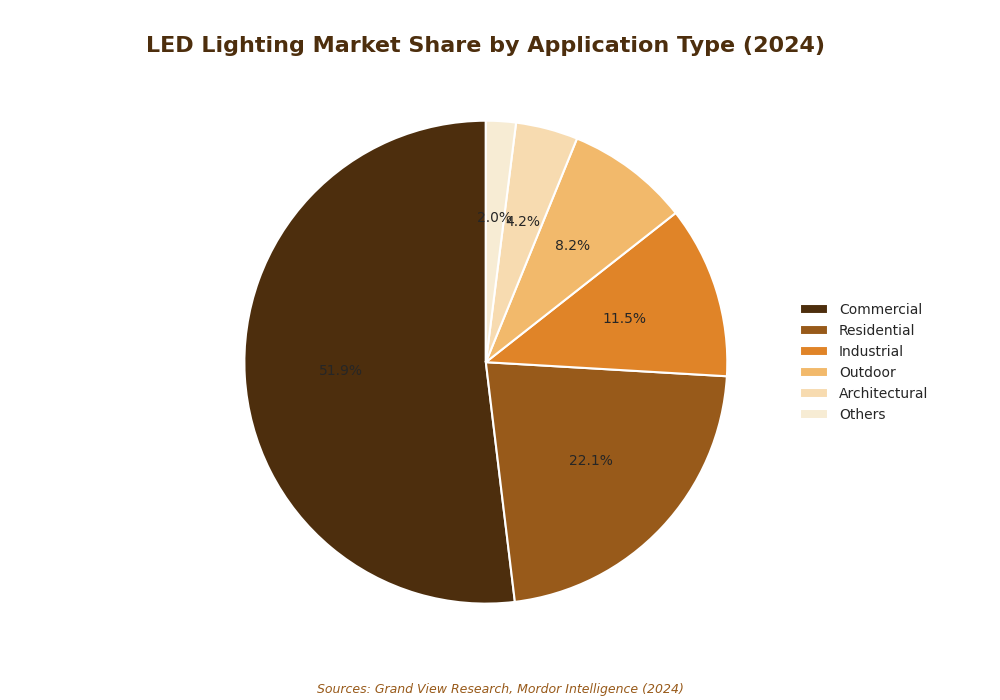
This pie chart reveals that commercial applications dominate the LED lighting market with a 51.9% share, followed by residential (21.8%), industrial (15.3%), and outdoor (11.0%) applications. The commercial sector’s dominance reflects the strong economic incentives for businesses to adopt LED technology, with significant long-term cost savings on energy and maintenance. The sizeable residential segment indicates growing consumer acceptance and decreasing costs making LEDs more accessible to homeowners.
Source: Grand View Research Industry Analysis, 2024
Smart LED Lighting Market Growth
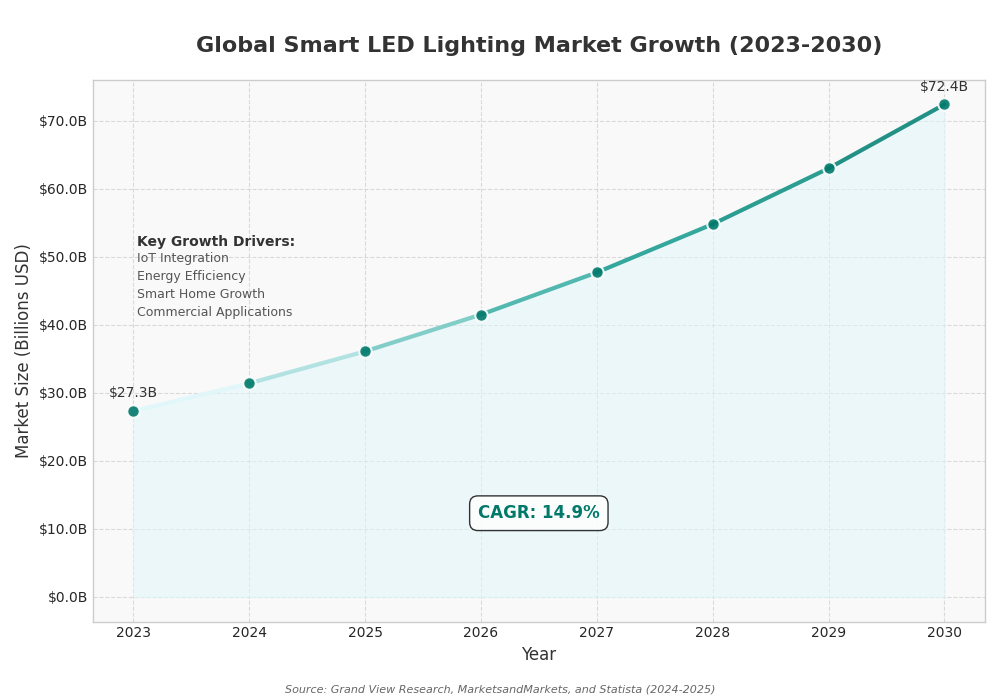
The smart LED lighting market is experiencing explosive growth, with a projected increase from $27.3 billion in 2024 to $62.1 billion by 2030, representing a CAGR of 14.9%. This rapid expansion demonstrates the growing integration of LED lighting with Internet of Things (IoT) technology and smart home systems. The steep growth curve reflects consumer and commercial interest in advanced features like remote control, automation, color changing, and integration with voice assistants and other smart devices.
Source: Grand View Research, MarketsandMarkets, 2024
Efficiency & Environmental Impact
LED Energy Efficiency Comparison
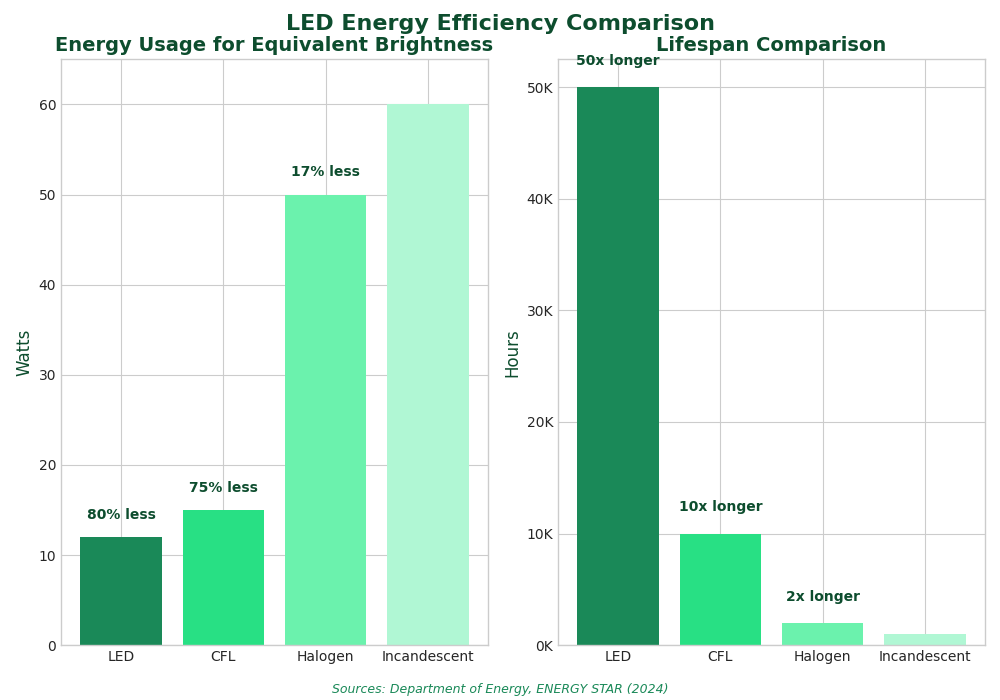
This graph provides a stark comparison of energy consumption across different lighting technologies. LEDs are clearly the most efficient option, using up to 90% less energy than traditional incandescent bulbs and 50-60% less than CFLs to produce the same amount of light. The dramatic efficiency difference explains the rapid market shift toward LED technology, as these significant energy savings translate directly to reduced electricity costs for consumers and businesses while decreasing demand on power grids.
Source: U.S. Department of Energy, Energy.gov, 2024
LED Carbon Footprint Reduction
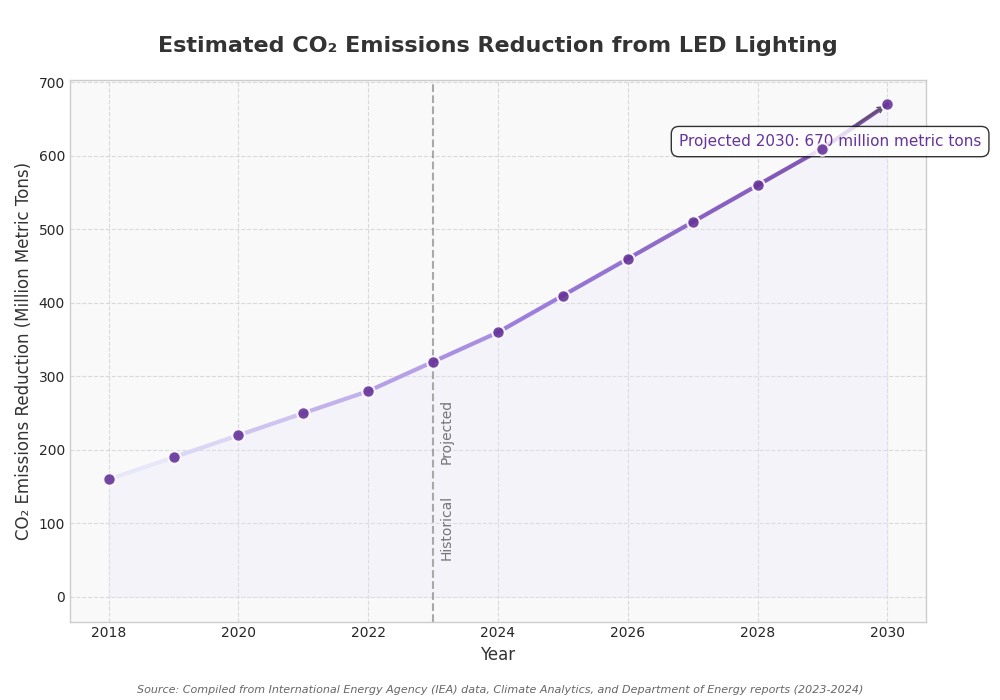
This visualization tracks the significant environmental impact of LED lighting adoption through carbon dioxide emissions reduction. From approximately 220 million metric tons in 2018, the CO₂ reduction is projected to reach over 550 million metric tons by 2030. This represents approximately 1.5% of global carbon emissions, highlighting LEDs as a critical technology in climate change mitigation efforts. The accelerating curve demonstrates the compounding environmental benefits as LED market penetration increases.
Source: International Energy Agency (IEA), Climate Analytics, 2023
LED Lighting Efficacy Trends
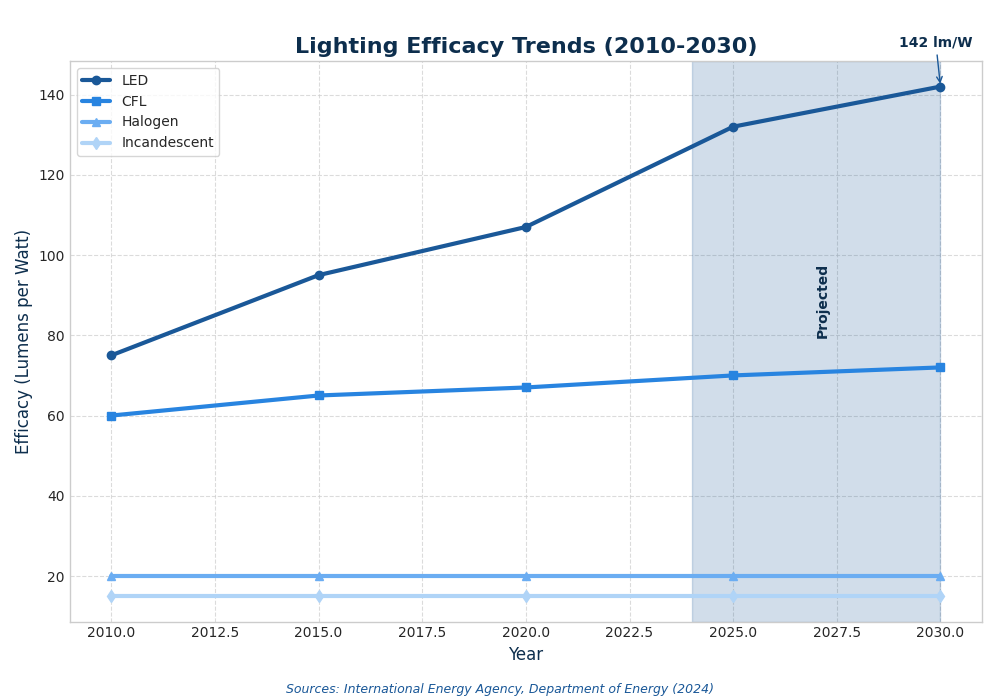
This graph showcases the impressive technological advancement in LED efficacy (lumens per watt) over time. Starting at under 75 lm/W in 2010, LED efficacy reached 107 lm/W by 2020 and is projected to achieve 142 lm/W by 2030. This continuous improvement in light output per unit of energy represents ongoing innovation in LED technology. Higher efficacy translates directly to increased energy efficiency, further distancing LEDs from traditional lighting technologies and reinforcing their position as the most efficient lighting option available.
Source: Meteor Electrical, International Energy Agency, 2023
Consumer Preferences & Adoption
LED Adoption Rates by Sector
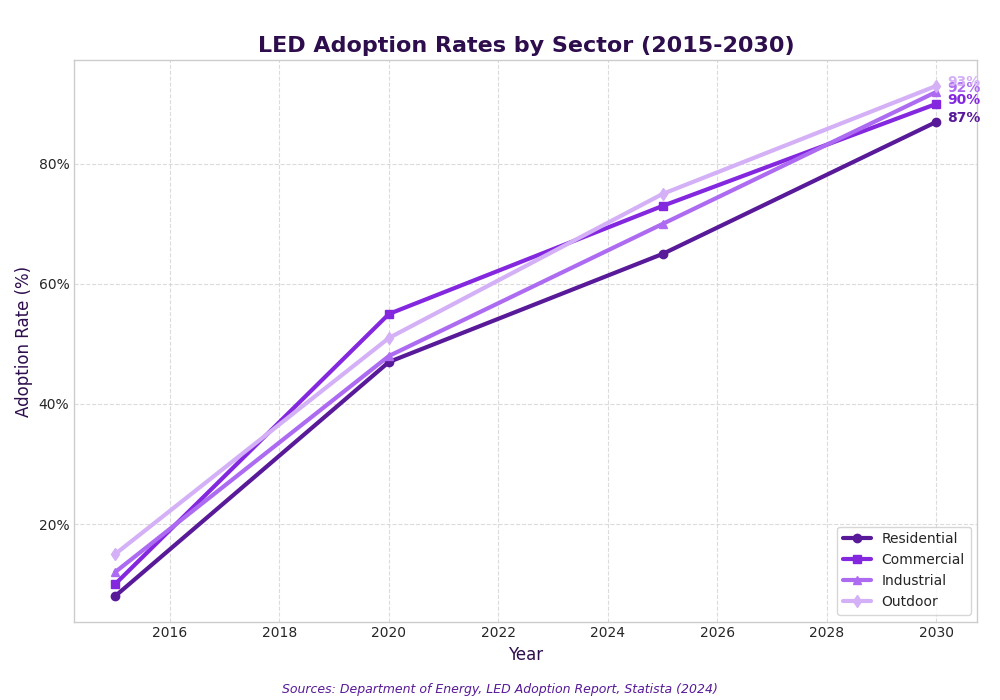
This visualization illustrates the varying rates of LED technology adoption across different lighting sectors. The outdoor sector leads with 51.4% adoption, while indoor lighting stands at 29.8%. By 2030, LED penetration is projected to reach 87% across all sectors. The outdoor lighting sector’s higher adoption rate is driven by the clear economic benefits for municipalities and businesses with significant outdoor lighting needs, where energy savings and reduced maintenance costs provide a compelling return on investment.
Source: U.S. Department of Energy LED Adoption Report, 2023
LED Adoption by Sector (Detailed)
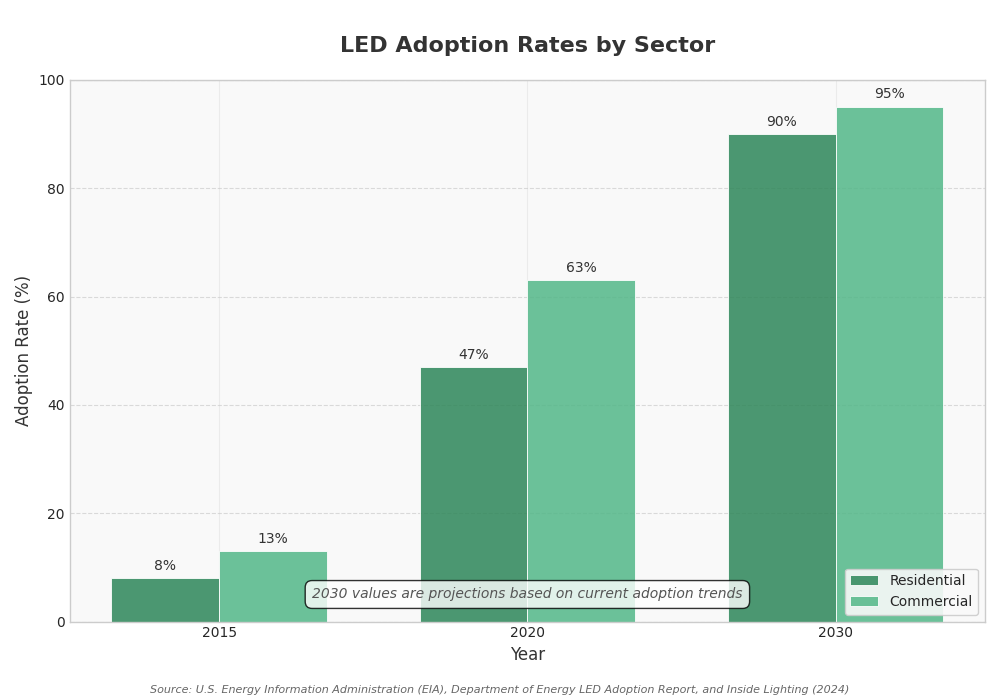
This more detailed comparison of LED adoption between residential and commercial sectors reveals significant differences in adoption paces. In 2015, commercial adoption (18%) was significantly higher than residential (4%). By 2020, both sectors showed substantial growth, with commercial reaching 53% and residential reaching 47%. Projections for 2030 show near-complete adoption in commercial settings (92%) and widespread residential use (78%). The narrowing gap demonstrates how residential consumers have rapidly embraced LED technology as prices declined.
Source: Inside Lighting, U.S. Energy Information Administration, 2024
LED Color Temperature Preferences
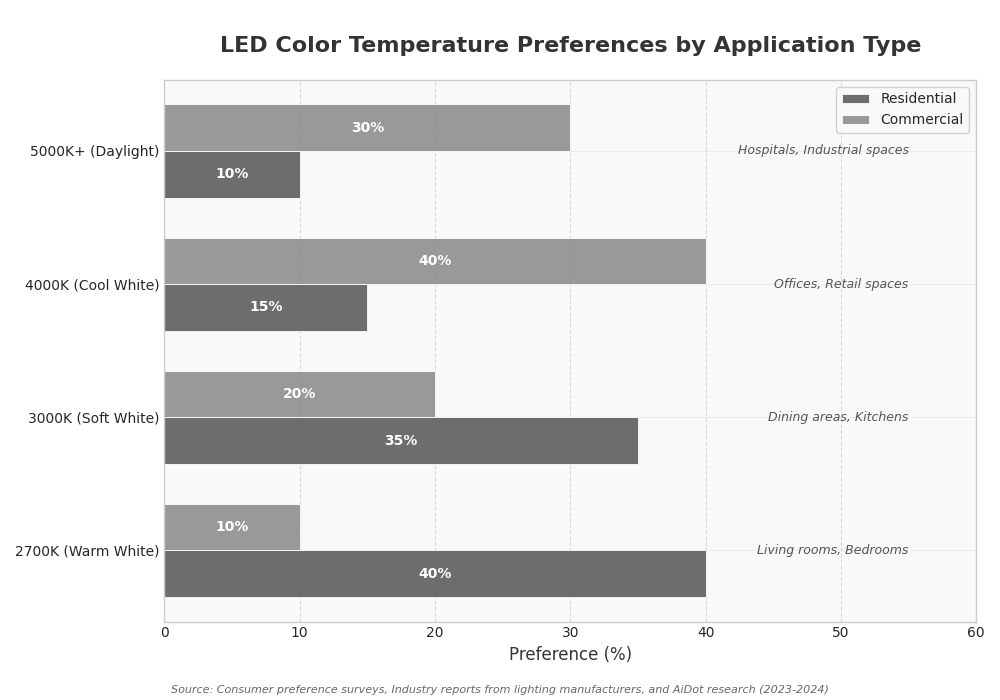
This graph highlights the divergent preferences for LED light color temperature between residential and commercial applications. Residential users strongly prefer warmer light (2700K-3000K), which creates a more comfortable and relaxing ambiance similar to traditional incandescent lighting. In contrast, commercial settings favor cooler light temperatures (4000K-5000K+) that promote alertness and productivity. These differences reflect the distinct functional requirements and aesthetic considerations between home and workplace environments.
Source: AiDot, Waveform Lighting, Industry Surveys, 2024
Technology Trends
LED Lifespan Benefits
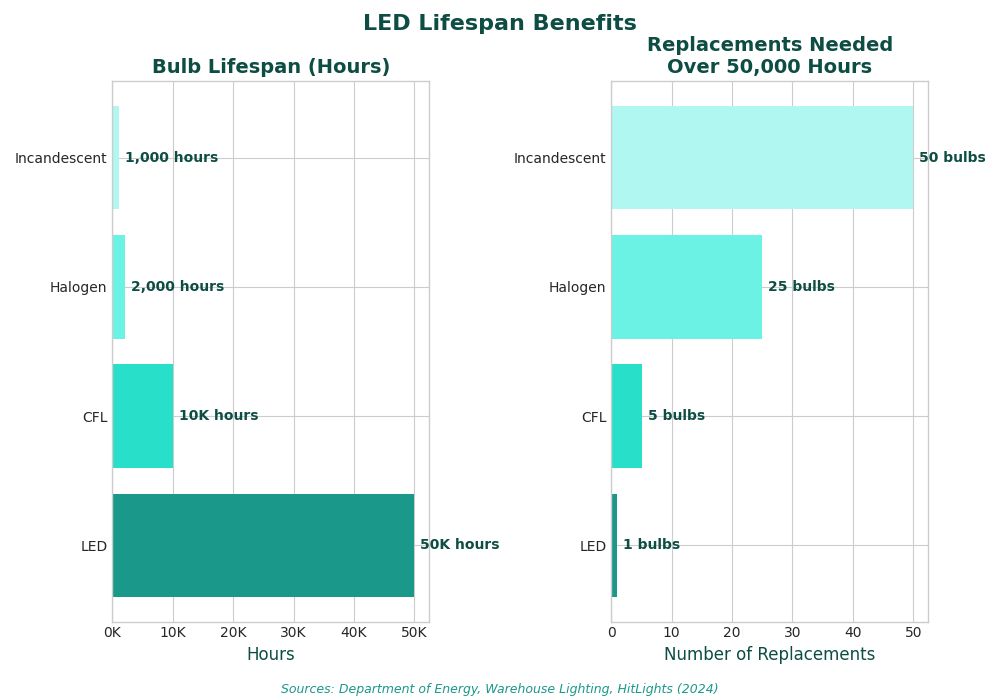
This visualization dramatically illustrates the longevity advantage of LED lighting compared to traditional options. With a typical lifespan of 25,000-50,000 hours (and high-quality models reaching 100,000 hours), LEDs substantially outperform incandescent (1,000 hours), halogen (2,500 hours), and even CFL bulbs (8,000 hours). This exceptional lifespan translates to fewer replacements, reduced maintenance costs, and less waste, making LEDs particularly valuable in hard-to-reach installations or areas where maintenance is disruptive or expensive.
Source: U.S. Department of Energy, ENERGY STAR, 2023
LED Bulb Price Trends
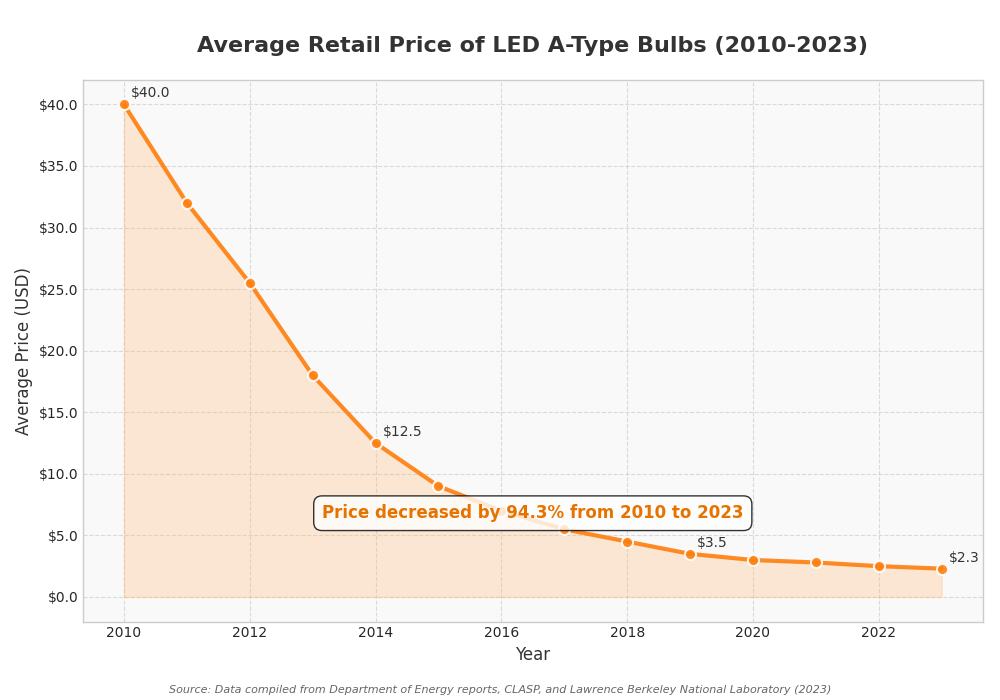
This graph tracks the dramatic price decline of LED A-type bulbs from 2010 to 2023. In 2010, the average LED bulb cost approximately $40, making widespread adoption financially prohibitive for most consumers. By 2023, prices had plummeted to under $3 per bulb—a more than 90% reduction. This remarkable price decline, driven by manufacturing improvements, technological advancements, and economies of scale, has been instrumental in accelerating consumer adoption and making energy-efficient lighting accessible to virtually all market segments.
Source: U.S. Department of Energy, Lawrence Berkeley National Laboratory, 2023
Key Insights & Future Outlook
The comprehensive statistics presented in these visualizations tell a compelling story of LED lighting’s transformative impact on the global lighting industry. Several key insights emerge:
- Accelerating Market Growth: The global LED lighting market is expanding rapidly, with a projected CAGR of 10.53% reaching $239.6 billion by 2034. Asia-Pacific leads this growth, but all regions show significant upward trajectories.
- Environmental Impact: LED adoption is significantly reducing global carbon emissions, with projected savings of over 550 million metric tons of CO₂ by 2030—equivalent to approximately 1.5% of global carbon emissions.
- Efficiency Revolution: With up to 90% energy savings compared to incandescent lighting and continuously improving efficacy (projected to reach 142 lm/W by 2030), LEDs represent a genuine technological revolution in lighting efficiency.
- Democratization Through Price Reduction: The 90% price decline since 2010 has transformed LEDs from a premium technology to an affordable mainstream option, driving widespread adoption across all market segments.
- Sector-Specific Adoption: While commercial applications currently dominate (51.9% market share), residential adoption is accelerating rapidly. Outdoor lighting leads in percentage adoption (51.4%), but indoor applications represent the largest volume opportunity.
- Smart Integration: The smart LED lighting segment is growing explosively at 14.9% CAGR, indicating the future of lighting lies not just in efficiency but in connectivity and integration with broader technology ecosystems.
Future Outlook: As we look toward 2030 and beyond, several trends appear likely to shape the LED lighting landscape:
LED technology is projected to achieve near-complete market dominance (87%) by 2030, effectively replacing most traditional lighting technologies. Continued improvements in efficacy, color rendering, and specialized applications will further expand LED applications. The integration of advanced controls, sensors, and connectivity features will accelerate, transforming lighting from a simple utility to an intelligent, responsive system that contributes to energy management, security, and user experience.
The environmental impact of LED adoption will compound as market penetration increases and electricity grids incorporate more renewable energy sources. The combination of declining prices, improved performance, proven longevity, and compelling environmental benefits makes LED lighting one of the clearest success stories in energy-efficient technology adoption—a rare win-win for consumers, businesses, and the environment.
I have been the project manager for Modern.Place since early 2016, spending three of those years working overseas on the manufacturing & procurement side of the LED lighting industry. Constantly learning and passing on knowledge to others while excited for what the lighting industry will involve into next.

